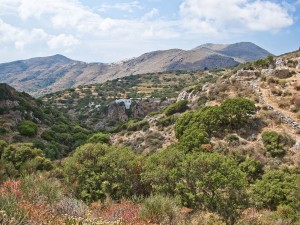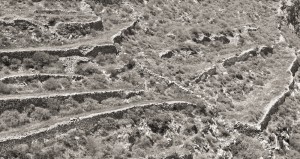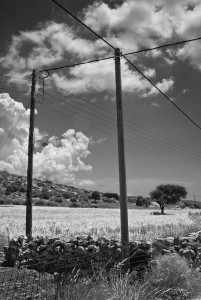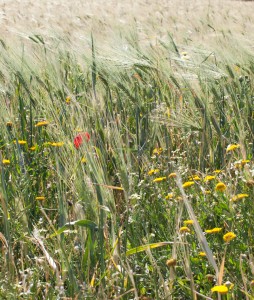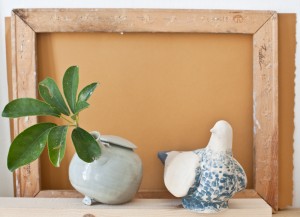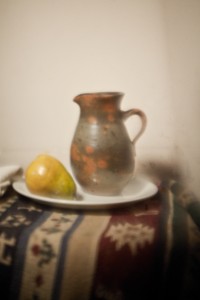I arrived here yesterday, 15 June. I checked into the Hotel Porto Sikinos (charming and comfortable) and knew that what I needed was a brisk walk and then a leap into the sea. So I did that. Nothing too strenuous or out of control. Then I cleaned up, i.e. took a shower, and rode the bus up the chasm that separates Alopronia (the port) from the Chora. It is a 5 km drive up the winding road. I was told there was a decent restaurant there. I ordered saganaki tiri, fried potatoes, fried eggplant and lamb chops (paidakia). It was pretty good but I know a lamb shoulder chop when I see it. “Paidakia”, my ass. OK. That’s what I give the restaurant–an ‘OK’. After a long day of travel I slept like a log and woke up around 8:30. The breakfast at the hotel was quite good, and plentiful. I skipped the bready things and ate the yogurt, boiled egg, both honeys, coffee and juice. Today I was going to hike to Episkopi! Yes, I did eventually get there, but it was adventure I am not eager to repeat. My fault, by the way. This is the rundown…
I chose a well-traveled path out of Alopronia up the Chora. No real worries, but I strayed off at one point and had to bushwhack through the thorny underbrush and eventually backtrack 500m downhill to where I joined the track again. I arrived in the Chora an hour later sopping with sweat. I refueled with some orange soda and bought some more water at a café. Good thing I did. I would need it.
There are two ways to reach Episkopi. The first is along the paved road that leads directly to the place. The other is a donkey track just off the paved road that also leads right to the ancient temple. Of course I chose the donkey track, or so I thought. What I chose was a different donkey track that mirrored, for a while at least, the one I currently trod. So I hiked along, enjoying the view of the archipelago (Folegandros, Milos, Kimolos, Sifnos, Andiparos, Paros and Naxos). Beautiful. Stunning. Then the path began to narrow. Hmmm…I continued since it was not a problem. Yet. Then as I was happily sauntering along I came around a corner and there was the fence. Shit. The path continued on the other side…I could see it. Then I realized my mistake. I should have gone back, it would have been easy enough, but no. I decided to go up and around the fence, or so I hoped. Long story short…
This led to a three-hour uphill, across ancient terraces, through thorns that would pierce leather (and my skin) trudge. I was able to find short stretches of paths, more goat tracks than anything else. Then they would disappear into a thorny mass. At this point I was aware of two things: I had not seen any goat droppings in a while and the foliage was becoming more and more wild. The fig trees were small and dried out, crackling under my grip. The olive groves were overgrown and unkempt, the trees stunted from the wind and unpruned. My reading of Homer told me that I was far from civilization. Oh yes…water…I had 1 full liter left. I was becoming disheartened, but what choice did I have but to keep pushing up and, I hoped, reach the road which I knew was there, yet I could not see? My excellent topo map gave me a pretty good idea where I was. So I scrambled and clawed my way through the thorns as they tore my skin. I climbed ancient terrace walls, carefully planting my feet and hands. Should one collapse, I was finished. No joke. I was getting worried. I began to remember what I had packed: Water, two cameras, my Swiss Army knife, two sarong for padding for the cameras. They were brightly colored. I could wave them to get someone’s attention in the case of an emergency, but there was no one around. I also had both my mobile phones. I ran several conversations through my head…I prayed a lot. Asked for all kinds of help: just 20 more meters; just over this terrace; just a little more. I was loath to drink my water. Only a half liter remained.
At one point the underbrush thinned slightly and I saw a real path. Stony, uneven, but going up and without many thorn bushes. Thank you, thank you…whoever. I moved up. I clambered over a small pile of stones and then I saw it: the guard rail. The road. The blessed road. Only 50 meters now…30…20…10 and I was up and out standing on glorious tarmac. I have never been so happy to see pavement. I looked to my left and there was Episkopi. I made it. The breeze was blowing. I began to feel chills, a sign of many things, almost all bad. I walked the 100 meters to the glorious and historical building, seeking shade. I walked along the side and plopped down on a small bench out of the sun. I dropped my pack, took off my shoes and socks, hung my soaked t-shirt on a wall to dry and took some deep breaths. Grateful, I leaned against the cool stone of the former-temple-of-Apollo-turned-Byzantine-church and blissfully felt my core temperature drop. I took out my watch. It was 2:20. Now to get back to the Chora and the port. There is a large cistern at the site and I refilled my water bottles but I needed potassium, salt and more water. Juices. Cold juices. And bananas. That’s what wanted. But first some pictures.
I made it back, dear readers, yes, I made it back. I have just counted the distance and I probably hiked a little over 12 km, the hard way. Tomorrow I go to the beach and relax. I will read my book, swim and let the antiseptic quality of the Aegean cure my lacerated limbs. Then I will nap. Tuesday I head to Folegandros. I will be there for 5 days. I am a lucky boy, in many ways.
JDCM



